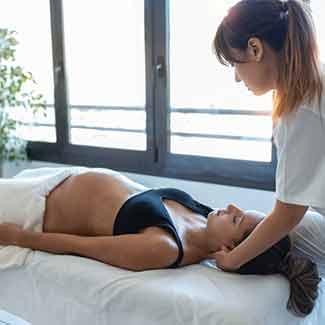What it’s all about
Osteopathy is a gentle approach based on the principle that musculoskeletal restrictions can impede the functioning of other body systems. Using manual techniques, osteopaths work on the body’s tissues to restore functional balance.
Pregnancy-related discomfort
During pregnancy, the body undergoes many physiological changes, including rapid postural deviations as the uterus expands. While some women adjust easily, others may compensate by adopting positions that cause discomfort, including strain in the lower back, abdomen, pelvis, neck, or upper back (often due to rounded shoulders). Sciatica and fluid retention are also common. A study shows that osteopathy can effectively relieve lower back pain during the third trimester, among other things.
Although many of these issues often resolve after childbirth, the effects can linger.
Osteopathic care
Osteopaths use gentle, hands-on techniques tailored to each stage of pregnancy, including mobilization, stretching, myofascial release, and muscle energy techniques. By providing relief, osteopathy helps women stay active, which keeps them from suffering the harmful effects of a sedentary lifestyle.
Conclusion
Osteopathy is a complementary approach to traditional medical care. A collaborative effort between healthcare professionals is the key for safe, personalized support. Whether to relieve muscle tension, improve posture, prepare the body for childbirth, or alleviate stress, osteopathy can be a valuable tool during pregnancy.
This article provides general information only, and is not a substitute for professional medical advice or care.
References :
1 Hensel KL, Buchanan S, Brown SK, Rodriguez M, Cruser dA. Pregnancy Research on Osteopathic Manipulation Optimizing Treatment Effects: the PROMOTE study. Am J Obstet Gynecol. 2015 Jan;212(1):108.e1-9. doi: 10.1016/j.ajog.2014.07.043. Epub 2014 Jul 25. PMID: 25068560; PMCID: PMC4275366.span>

